
Kom Ombo
![]()
| This temple, located 40 km north of Aswan, is built on a high dune overlooking the Nile in the town of Kom Ombo. The temple is dedicated to the deities Sobek, the crocodile god, and Haroeris (Horus the Elder), the hawk-headed god of the morning sun. It dates mainly to the Ptolemaic and Roman periods (332 BCE - CE 395), most of its relief decoration having been completed in the first century BCE. The architectural plan of the temple is unusual in that it effectively combines two traditional cult temples into one. Each side has its own individual sanctuary and offering tables to avoid any jealousy. |
![]()
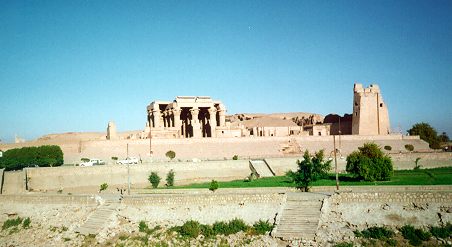 The Kom Ombo temple complex as seen from the Nile. The Temple of Sobek and Haroeris is in the middle
of the picture. The large structure on the right is the Gate of Neos
Dionysos although scholars disagree over the number, order and dates of the
various Ptolemys, each of whom adopted a title such as Soter (Savior), Euergetes
(Benefactor) or Philometor (Mother Lover). Some identify Neos Dionysos as Ptolemy
XII, others as Ptolemy XIII.
The Kom Ombo temple complex as seen from the Nile. The Temple of Sobek and Haroeris is in the middle
of the picture. The large structure on the right is the Gate of Neos
Dionysos although scholars disagree over the number, order and dates of the
various Ptolemys, each of whom adopted a title such as Soter (Savior), Euergetes
(Benefactor) or Philometor (Mother Lover). Some identify Neos Dionysos as Ptolemy
XII, others as Ptolemy XIII.
The
facade of the hypostyle hall at dusk. Its surviving columns burst in
floral capitals beneath a chunk of cavetto cornice bearing a winged sun disc and twin uraei
above each portal. The forecourt, reduced to low walls and stumps of pillars, is
also partially visible.
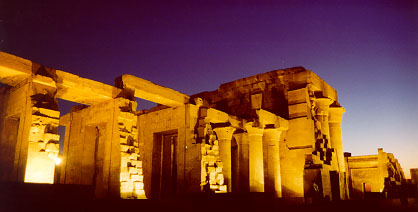 A view of the northern
(Haroeris) side of the temple at dusk
A view of the northern
(Haroeris) side of the temple at dusk
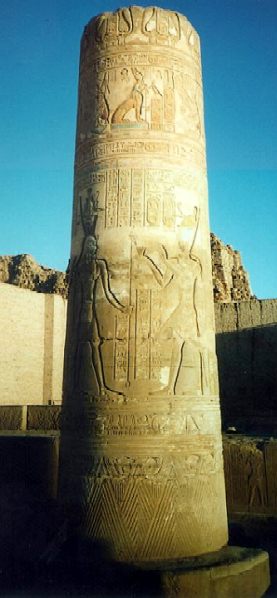 One of the columns inside the first Hypostyle Hall.
The columns have either the heraldic lily of Upper Egypt or the papyrus symbol of
Lower Egypt carved on their bases.
One of the columns inside the first Hypostyle Hall.
The columns have either the heraldic lily of Upper Egypt or the papyrus symbol of
Lower Egypt carved on their bases.
 A tiny relief of a woman
giving birth and a woman breast-feeding between the doors leading to the inner vestibule,
at roughly waist level.
A tiny relief of a woman
giving birth and a woman breast-feeding between the doors leading to the inner vestibule,
at roughly waist level.
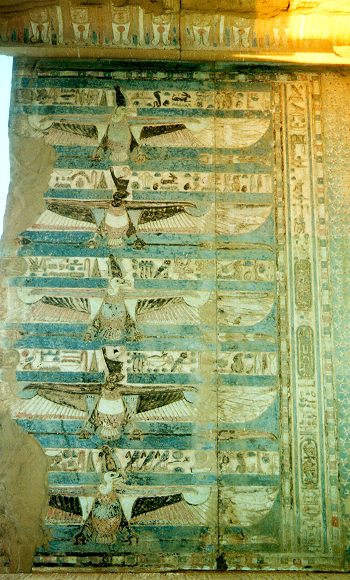 The left side of the ceiling
of the first Hypostyle Hall is decorated with flying vultures wearing the
crowns of Upper and Lower Egypt.
The left side of the ceiling
of the first Hypostyle Hall is decorated with flying vultures wearing the
crowns of Upper and Lower Egypt.
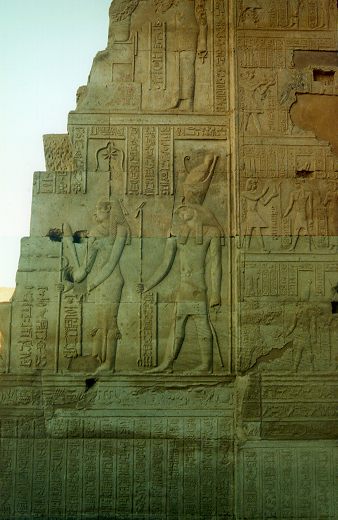 The goddess of writing and
measurement, Seshat, and Haroeris,
holding a was scepter, on a
wall panel located on the first of the three vestibules decorated by Ptolemy VI.
The goddess of writing and
measurement, Seshat, and Haroeris,
holding a was scepter, on a
wall panel located on the first of the three vestibules decorated by Ptolemy VI.
 Egyptian Numerals
on one of the walls of the temple. Starting at the top right, the numbers are
increasing as you read down from the top of the column towards the bottom (25, 26, 27,
28). Following those numbers are three sets of hieroglyphs that exceed my meager
deciphering abilities, then the last four numbers on the bottom right are 2, 3, 4 and 5
(again, reading top down).
Egyptian Numerals
on one of the walls of the temple. Starting at the top right, the numbers are
increasing as you read down from the top of the column towards the bottom (25, 26, 27,
28). Following those numbers are three sets of hieroglyphs that exceed my meager
deciphering abilities, then the last four numbers on the bottom right are 2, 3, 4 and 5
(again, reading top down).
© All pictures are Copyright 1998 - 2001 Grisel Gonzalez